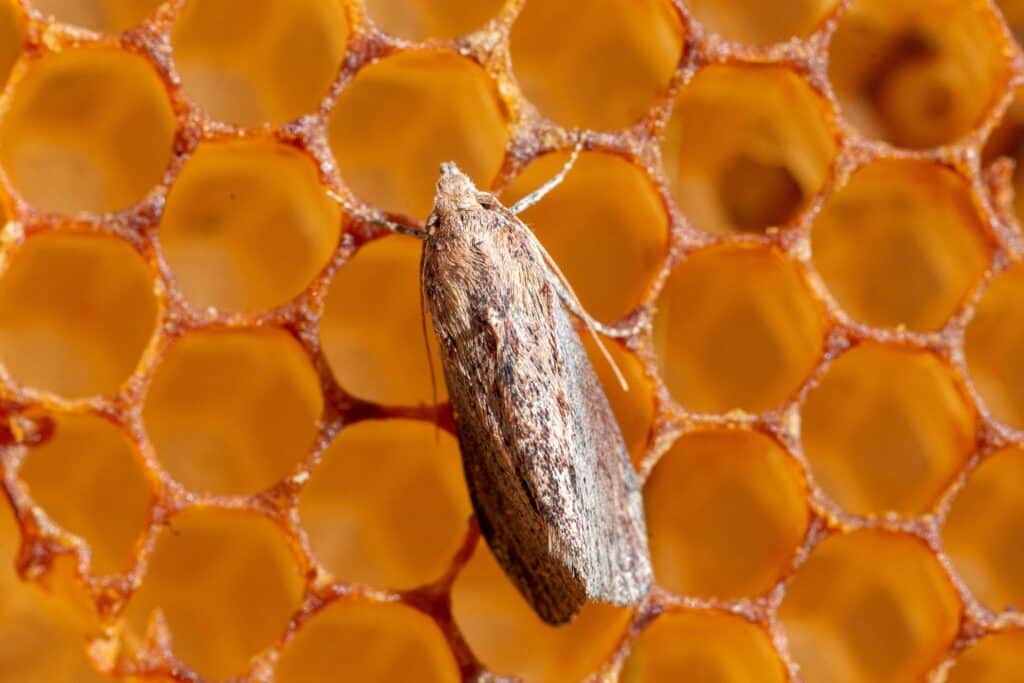Wax Moth
Galleria mellonella
The Wax Moth larvae are more dangerous than the adult.
Advertisement
Wax Moth Facts
- Prey
- Beehives
- Name Of Young
- Wax Worms
- Group Behavior
- Social
- Fun Fact
- The Wax Moth larvae are more dangerous than the adult.
- Biggest Threat
- predators
- Most Distinctive Feature
- Additional Legs + 3 sets of thoracic legs
- Gestation Period
- 5-8 days
- Wingspan
- 31 mm
- Litter Size
- 300-600 eggs
View all of the Wax Moth images!
The Wax Moth has two different species; the Greater Wax Moth and the Lesser Wax Moth. Both the species, prey on hives and eat beeswax. They are quite destructive and can rapidly chew through combs to devour wax, pollen, larval honey bees’ remains, honey bee cocoon silk, and even enclosed honey bee feces. But they are beneficial to the environment because they can eliminate a dead bee hive colony.
Species, Types, and Scientific name
Wax Moths are Achroia, belonging to the family Pyralidae, and come from the order, Lepidoptera. There are only two known species, known as:
- Galleria mellonella
- Achroia grisella
These moths are initially white in color but gradually become greyish brown as they grow into an adult. You can spot them lurking in the impurities of a honey bee comb. Although they prefer to eat the unprocessed wax, they can also occasionally eat the impurities like feces and the remains of the dead larvae of honey bees. In addition, they are found almost everywhere on Earth. Many call it beneficial for the Earth’s environment but a little too much of their processing can cause damage to the bee hive.
Appearance
The two different species of the Wax Moth differ in their physical appearance. The Greater Wax Moth is 20 mm long, having a pale brown or grey body as adults. In contrast, the Lesser Wax Moth is smaller, paler, and slimmer. They are only 13 mm in length and have a pale yellow body.
A distinct quality about their body is the presence of their wings. The grey wings appear boat-shaped when the Wax Moth is not in the use of the wings and they lay perfectly still, folded on top of their bodies. The wingspan is usually about 3 mm for the Greater Wax Moth. In addition, the larvae of the Wax Moth are also known as wax worms and they are used as live bait in catching fish.
The female can be differentiated from the male on the basis of an indentation in the wings. In contrast, the region is straight in males.

Wax moths prey on beehives and eat beeswax. They’re incredibly destructive to hives.
©Ihor Hvozdetskyi/Shutterstock.com
The eggs and larvae are quite similar. They are pink in color and grow larvae that are 28 mm long. They can travel up to 50 mm and mark the tunnels with a silky web. A female wax moth can lay 300 to 600 eggs in one reproductive cycle.
At the larval stage, the Wax Moth is often mistaken for another insect’s larvae known as the small hive beetle. But the key to identifying them is through their thoracic legs. They include three sets of thoracic legs at the rear of the body and additional sets of legs present in the rest of the body. The additional legs are not found in a small hive beetle.
Another insect known as the bee moth (Aphomia sociella) is also quite similar to the Wax Moth. Its body is reddish-brown in color as adults while its larvae are yellow in color during their growing phase. Its female species has a distinctive quality that easily differentiates it from the rest, carrying a dark spot. But this bee moth is attracted to the bumble bee and the wasps’ species’ nests.
The behavior of the Wax Moth depends on the species as well. The Lesser Wax Moth prefers solitary time but the Greater Wax Moth travels in the form of groups. They like flying at night and rapidly infest a new hive within minutes.
Habitat: Where to Find Wax Moth
The Wax Moth is found all over the world, mainly in Europe, North America, Russia, and Turkey. They are also present in Australia and are relatively new. But whichever country they choose as their home, they consider living in a beehive.
They are usually present in the parts of the hive where the bees cannot access them. They require low ventilation, warm temperatures, and low light to grow and rapidly spread.
Its larvae can take up to 20 days to grow in a warm climate but when the weather turns cold, the larvae can take up to as long as 5 months to grow into adults. During this phase of growth, the larvae reside in the wooden frames of the beehive. They burrow the comb, chewing off the wooden frame until it has permanently become damaged. Then, they mark their territory by leaving a silk web along the comb which fuses various combs into one.
If there is a Wax Moth infestation that can leave a comb completely destroyed, you can spot it through the following indicators;
- The larvae can do more damage than an adult Wax Moth.
- Their population usually rises in abandoned or weakened hives.
- There will be silk throughout the combs in the first stage.
- It will be followed by deposits of dark fecal matter found within the hives.
- Soon, you will spot debris and comb remnants on the now-dead beehive.
Diet
What does Wax Moth Eat?
The Wax Moth mainly devours the unprocessed wax in beehives. But it also enjoys pollen, remains of larval honey bees, honey bee cocoon silk, and enclosed honey bee feces found on brood cells as part of its diet.
What Eats Wax Moth?
The Wax Moth worms or the larvae are eaten up by hedgehogs, salamanders, birds like the great honeyguide, ceratophrys frogs, and even newts. Considering the larvae do more damage than the adults, it is best to expose them to such animals. In certain countries, humans cook and snack on the larva of these moths!
How much does the Wax Moth eat?
There is no general estimate as they can gobble down the beehive till it is completely destroyed. They also ruin the honey, making it inedible for humans.
Prevention
The thing about these mmoths is that they cannot be completely eliminated but consistent management can reduce their population to a great extent. The best eliminator is, of course, the bees. But if you are looking for a different kind of prevention, here are a few tested methods;
Apiary hygiene
The first and foremost treatment for this type of moth is to keep a clean and hygienic environment to prevent Wax Moths infestation. They prefer indulging in the impurities of the beehive and they thrive upon it.
Storing Combs
Another effective method to prevent an infestation is to store the honeycombs from the late autumn and reuse them in the early spring season. This is effective only if the winter season of the state has the right temperature. Some beekeepers even utilize bee colonies on top of these hives that prevent the Wax Moth from taking charge and growing.
Cold Temperatures
The temperature of the atmosphere if kept under -7 degrees, can help kill the wax moths within 4 to 5 hours at maximum. This method is effective for all life stages of the Wax Moth and can help kill the moths completely. However, there may be a need for putting the beehive in a dry environment to prevent mold from occurring and ruining the honey inside it.
Similar Insects
Check out some of the other articles we have about moths around the world.
View all 108 animals that start with WWax Moth FAQs (Frequently Asked Questions)
Are Wax Moths dangerous?
They are quite destructive and can ruin a whole colony of beehives until they are completely destroyed.
Will bees clean up wax moths?
Yes, in most cases, they do eliminate the wax moths.
Are Wax Moths Harmful to Humans?
They are not directly harmful to humans but they can infect the honey causing it to be indelible.
How do you identify Wax Moth?
On the basis of their three sets of thoracic legs along with multiple pairs of additional legs.
Thank you for reading! Have some feedback for us? Contact the AZ Animals editorial team.
Sources
- National Bee Unit, Available here: https://nationalbeeunit.com/index.cfm?pageid=207
- University of Florida, Available here: https://entnemdept.ufl.edu/creatures/MISC/BEES/Achroia_grisella.htm
- Bee Aware, Available here: https://beeaware.org.au/archive-pest/wax-moth-18/#ad-image-0
- Wikipedia, Available here: https://en.wikipedia.org/wiki/Lesser_wax_moth

















